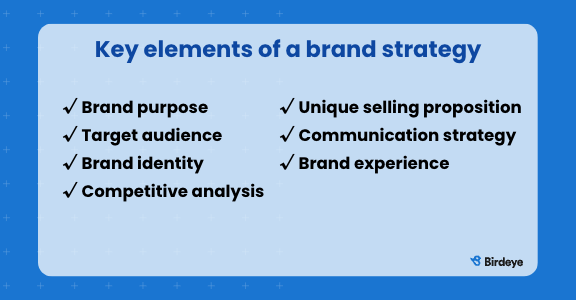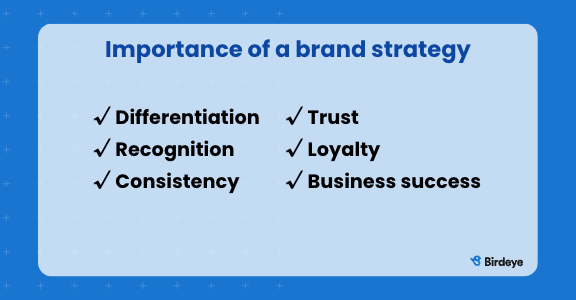Are you looking to build a successful brand? Do you want to create an engaging and memorable customer experience? If so, then developing a strong brand strategy is essential.
A well-crafted brand strategy can help your business stand out from the competition, allowing it to reach its full potential. But creating such a plan isn’t easy — it requires knowledge of marketing techniques, research into customer behavior, and understanding how people interact with brands.
In this blog post, we’ll explore the secrets behind successful branding strategies, discuss why it’s important for businesses to have one, and look at real-life examples.
Table of contents
What is brand strategy?
Put simply, a brand strategy is a plan to help position your business in the marketplace. It outlines how you want your customers to think and feel about your brand and helps guide how you communicate with them.
An effective brand strategy should include relevant messaging, a communication channel strategy, and a deep understanding of your target audience. Let’s look at other key elements for an effective brand strategy.
Key elements of a brand strategy

While it may be useful to think of your brand as the public face of your business, it would be unwise to limit your brand solely to its logo, name, or slogan. To guide you further, let’s look at seven key elements of a brand strategy you’ll need to incorporate.
Brand purpose
Think of the purpose of your successful brand strategy as your “why.” For example, what inspired you to start your business in the first place? Think about what innovations you’re introducing or consumer problems you’re uniquely positioned to solve.
Have a clear understanding of your brand’s mission, value, and overall purpose. A successful brand strategy extends beyond just the prospect of sales and earnings. It connects the brand to its purpose and the values of the organization, allowing it to build an emotional connection with its audience. Ideally, it will appeal to potential customers, along with your existing fans, when executed correctly.
Target audience
The audience is crucial to any successful brand strategy. Your business will need to know who your customers are and how to connect and interact with them. And you’ll want to do so while balancing their needs, wants, and preferences.
Another way of looking at this particular element of a brand strategy is to identify what’s in it for your customers. Knowing how they benefit from your products and services will keep you aligned with them ongoing. Don’t underestimate the importance of thorough market research in order to fully understand your potential customer base, too.
Brand identity
One branding method that successful businesses implement is brand identity management. Business leaders think of their brand identity as the walking, talking visualization of their brand. In other words, imagine what your brand would look like if your business were a person. Dive further and define what personality and values it might have.
Your brand identity combines several factors, including your:
- Brand voice – This will set the tone for the consumer relationship.
- Brand story – Why you exist and why you started?
- Brand design – Logo and tagline.
Keep your brand identity in mind when creating your messaging and communication with customers. For example, posting on social media should align with your brand’s identity to impact how your audiences see you.
Competitive analysis
A key component of creating your brand strategy will be analyzing your competition. Review their strengths, weaknesses, and what distinguishes them from you. Use those insights to create your own unique angle that stands out from the rest. You’ll also want to know the latest market trends and industry advancements. That’ll help you stay ahead of your competition, too.
Finally, keep in mind that not all competitors are created equal. Identify which companies are direct or indirect competitors so you can craft a strategy specific to each one. That way, your brand strategy will be tailored to compete favorably in the market.
Unique selling proposition
After finishing your competitive analysis, identifying your brand’s unique selling proposition becomes much easier. Essentially, your unique selling proposition will be the reason consumers come to you rather than the competition.
To find this, brainstorm the qualities that make you stand out from the crowd. Then look for ways to communicate those features with your customers in an engaging way. A good example of a unique selling proposition is Domino’s promise of a hot, fresh pizza delivered to your door in 30 minutes or less. If it’s not, the pizza is free.
Once you’ve identified your unique selling proposition, make sure it’s communicated clearly and concisely. It should be prominently displayed on your website and in all of your marketing materials.
Communication strategy
A communication strategy examines who you are talking to, what message they need to hear, who will be responsible for communication, and which channels you use. If your ideal customers prefer TikTok over Facebook, your presence should focus on TikTok.
Communication should also be consistent. Use the same voice, style, and tone, even if your messaging is different. Keep it aligned with your brand identity so people associate your messaging with your brand.
Brand experience
Once you have your communication strategy in place, the next item to tackle will be your brand experience. If communicating with your audience brings people to your store, website, or social media page, then you’ll need to ensure that all these pursuing interactions and experiences with your brand are consistent and positively received.
Your brand experience will need to relate back to your overall purpose and identity. Internally, you’ll want to ensure your employees are given the skills, resources, and confidence required to implement a successful brand experience that consistently delivers time and time again.
Related read: 19 essential marketing skills you need to master
Importance of a brand strategy

So far, we’ve looked at the key elements of a brand strategy. In this section, we examine why having a brand strategy is important and how revisiting it will help drive and grow your business.
Differentiation
This factor tops our list for a reason. Knowing what makes your business different from the others is advantageous in a world with increasingly stiff competition.
If your business can’t differentiate itself from its competitors, then consumers will have no compelling reason to use your products or services over another business. In other words, the more convincing the difference between your business and your competitors, the more likely you’ll be able to step ahead of your rivals and deliver a unique customer experience.
Recognition
Recognition is crucial when building trust and credibility with your customers. When they’re ready to take the next steps and follow through with a purchase, your brand is already firmly planted at the forefront of the customer’s mind over your competitors.
Branding helps your business become recognized more often and stay in the consumer’s mind for longer.
Consistency
Consistency means your teams know what they’re doing and have sufficient clarity to communicate the value of the business across all customer touchpoints. They’ll be able to do so while minimizing confusion, stress, and frustration.
This creates a coherent and unified brand experience.
As an example, think of McDonalds. No matter what restaurant you visit, you know the Big Mac is going to be built the same way. There might be different promos at varying restaurants. But customers know exactly what a Big Mac is supposed to look and taste like when they order one.
Trust
A successful brand strategy seeks to create trust with its audience. And achieving trust without branding can be tough for new businesses. However, if you incorporate the steps we’ve outlined above, you’ll show potential consumers that you’re a credible business.
It also sets clear expectations, like with the Big Mac example. Eventually, your customers will learn to associate your brand with quality, reliability, and positive experiences.
Loyalty
More often than not, businesses rely on a nurturing model which sees customers returning to the business as opposed to a one-off experience. A successful branding strategy allows you to connect with your ideal prospects on a deeper emotional level to help maintain the relationship. These connections are essential to converting your first-time user into an avid loyal fan. And it leads to a boost in repeat business, positive customer reviews, and memorable brand experiences.
Business success
According to research, consistency alone in your brand presentation can increase revenue by up to 10 – 20%. Research also suggests that implementing branded social media videos into your brand strategy can lead to a direct increase in sales.
These are just two ways brand strategy can lead to business success. Therefore investing in your strategy early on will pay dividends in more ways than you’ll be able to count. There is some evidence that also suggests that a successful brand strategy can reduce employee turnover as well, meaning you’ll ultimately spend less on staff training and resources. Effective branding strategies will drive revenue growth, market share, and customer retention and enhance your reputation.
Examples of successful brand strategies
Apple: Minimalistic brand design

Apple has a minimalistic brand design that is easy to recognize. And the iconic bitten apple symbol has become closely associated with the brand. The company builds an unrivaled emotional attachment with its customers using advertising, product launches, and website interactions. It creates an exclusive club of Apple users, too, elevating the brand’s status.
Dove: Campaign for Real Beauty

Through Dove’s Campaign for Real Beauty, the well-known personal care company has built a reputation for promoting natural beauty. This campaign aims to make women feel comfortable with their bodies. The company tapped into social media, magazines, and TV ads to showcase “real people” who weren’t airbrushed or altered. In its mission to celebrate natural beauty, Dove appealed to consumers who could identify with these non-altered models.
Ben & Jerry’s: Socially responsible brand

Ben & Jerry’s has a unique brand identity. It’s not just delicious ice cream. The company also promotes social responsibility and sustainable practices. For example, it uses fair trade ingredients, creates a positive work-life balance, and supports environmental causes. The company leverages social media to raise awareness about its efforts and to align with its core demographic.
Frequently asked questions about brand strategy
A successful brand strategy needs to identify a clear brand purpose, target audience, brand identity, competitors, and unique selling proposition. Then create a strategy that enforces each with every communication and marketing effort.
To develop a brand strategy, decide first what unique experience your business offers. Then consider specific values or goals to tie into your product or service. Finally, you can carve out what it is that sets you apart from your competition.
Businesses can use these four branding strategies to develop a successful brand:
1) Identify a clear purpose.
2) Figure out your target audience and the best ways to engage.
3) Establish a unique identity.
4) Analyze competitors and create a unique selling proposition.
By combining these tactics with creative marketing campaigns, businesses can reach more customers and generate stronger loyalty.
Rise to the top with a brand strategy
A brand strategy is essential for any business looking to stand out from the competition and make a lasting impression on consumers. With careful planning, research, and execution of your unique values, purpose, vision, identity, culture, and voice, you can create a successful branding campaign that will keep customers coming back. Investing in your brand should always be seen as an investment in the future success of your company – so start strategizing today.

Originally published









